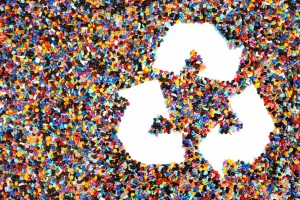The PUPC also published a document on the classification of hazards posed by PVC waste, developed within the framework of the VinylPlus program. The aim of the report is to provide a summary of the current knowledge about recycling and demonstrate how it can be used by companies operating in the recycling chain. Recycling is the processing of waste materials with the intention to create a new product that can be sold again. This is the main goal of recycling, however the overriding objective is protecting the environment from hazardous substances contained in waste and the protection of natural resources. We can distinguish between the following types of recycling: material, raw material, chemical, thermal and organic recycling.
The main source of PVC waste is the construction industry (windows and doors), obsolete piping systems, e-waste and waste from the automotive industry and households. Postconsumer PVC waste can be recycled. In recycling window frames, which belongs to the material recycling type, waste produced during renovation and demolition work is processed. Glass and metal parts are separated from the waste, then crushed and reused for the production of new window and door profiles in a mixture with a fresh raw material. A relatively large percentage of plastic waste is obtained from roofing materials. Recycling of this type of waste involves its initial sorting, followed by cutting and cleaning. The PVC chips are ground at low temperature, thanks to which the waste remains hard and a high granularity can be achieved. The raw material obtained thus is used as an addition to the original material.
Unfortunately, PVC recycling is the least preferred method of its disposal. The vast majority of it ends up at the landfill (ca. 80%) and in incinerators (ca. 15%). Why is this the case? The main problem with this type of waste is that it can contain additives, which had been legal in the past, i.e. the first time the products were produced. Currently the waste and the recycled granules produced therefrom, carry the risk of being classified as hazardous products. Some of these substances may also be subject to restrictions and approvals required by the REACH directive (“older additives”). They have been completely or almost completely replaced with primary raw materials, but they can still be found in products intended for permanent use such as waste from renovated or demolished buildings.
In accordance with the decision of the EU Commission, waste management companies are obliged to select a code from the Waste List when they undertake to recycle waste. In the case of PVC, the code is either 17 02 03 (“Plastics”) for construction and demolition waste not considered as hazardous or code 17 02 04 for glass, plastics and wood containing or contaminated with hazardous substances. In these cases, EU law states that the choice must be made on the basis of the hazardous properties posed as understood by Appendix 3 to the Waste Framework Directive.
The list of waste products and the definition of hazardous waste as defined by the Waste Framework Directive had been in force for many years.However, on 01 June, 2015, Regulation KE 1357/2014 came into force and superseded the former Appendix 3 of the Waste Framework Directive. The previous Appendix III defined 15 “properties of waste that made them hazardous”.The assignment of the hazardous properties was performed on the basis of Appendix VI to Directive 67/548 on the classification of dangerous substances.The new Appendix 3 defines the concentration limits, above which the presence of dangerous substances automatically qualifies the waste as hazardous.A suitable limit concentration for reproductive hazard categories 1A and 1B (includes Pb compounds but does not apply to high molecular weight phthalates, non-phthalate plasticisers, i.e. Oxoviflex® and low molecular mass phthalates) is 0.3%. The handling and transportation of hazardous waste is subject to very restrictive permit and reporting procedures. The classification of waste as hazardous may also rid the waste from the possibility of reaching the end of its waste status, i.e. before it is introduced on the market as a product.All of this discourages the European recycling business, which has already been weakened by the disadvantageous business conditions, from investing in the further development of PVC recycling.These restrictions may also put an end to postconsumer waste recycling and discourage recyclers from developing the market of products containing recycled materials.
The EU Commission is well aware of this fact and in 2014 it requested the German consulting firm BiPRO to carry out a study to “assess the possibilities of excluding specific plastic and rubber waste types from the EU Waste List”.The results of the study were published on 8 May, 2014. The study also included tests of the migration of certain heavy metals and the DEHP plasticiser from PVC waste into water, which were carried out by the German FABES Institute at the request of VinylPlus.FABES’ study results confirm that the migration of dangerous substances from hard PVC waste is very low, while from soft PVC is has been classified as “rather low”.The results clearly indicate that the migration of substances from PVC products or waste is much lower than the migration from a simple PVC blend containing additives.

